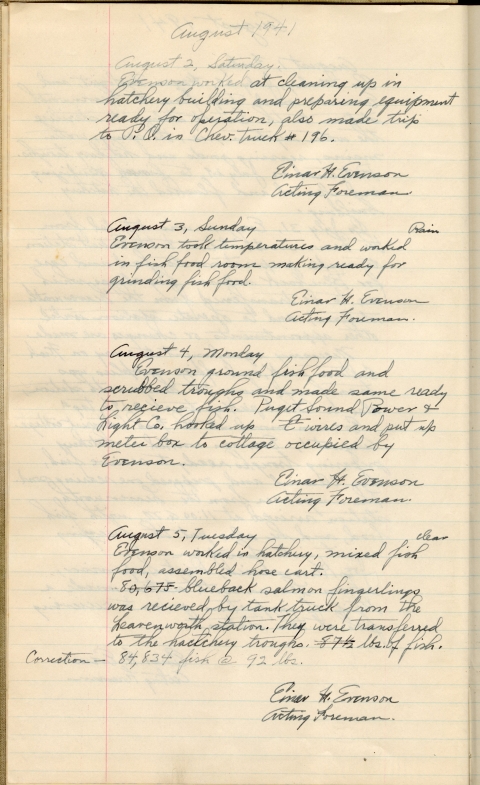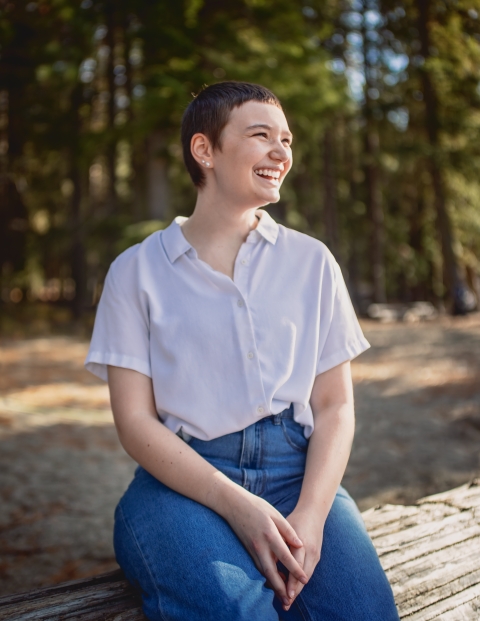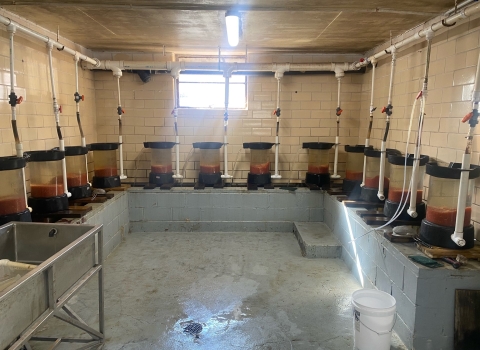“We call this Uncle Chris’s attic,” said Paul Levsunov, an employee at Winthrop National Fish Hatchery, referencing Chris Pasley, the hatchery’s manager since 1998. We stood together in the dusty space, surveying the piles of equipment, bins, and boxes laid out on the old wooden floorboards. He was helping me carry heavy totes full of precious paperwork down the narrow stairs, preparing for a journey to safekeeping in South Dakota.
The first time I entered the attic years earlier, files and photos filled boxes stacked on the floor and old cabinets. It was a treasure trove of details about the daily life of the hatchery. But an attic is not the place for these delicate paper records. Luckily, a place exists for the exact purpose of preserving hatchery history: D. C. Booth Historic National Fish Hatchery and Archive in Spearfish, South Dakota. Their state-of-the-art storage was where these records belonged.
The hatchery in Winthrop is not the only one I work for. I prowled the attic at Entiat National Fish Hatchery, which had served as a laboratory decades earlier when the hatchery was a research station aiming to learn how to keep fish healthy in captivity. And at Leavenworth National Fish Hatchery, I was already too late for many records, many of which had been thrown out. But plenty remained, mostly crammed into the second floor of one of the hatchery houses, in use since the 1990s as office space for Friends of Northwest Fish Hatcheries.
In short, there were stacks and stacks of photos and files to be sorted and, preferably, digitally scanned before being transported to D.C. Booth. It was a daunting task, and not one I could do alone. But I knew the perfect person to get things started. When I worked in Alaska Peninsula and Becharof National Wildlife Refuges, I worked with a volunteer who was a retired librarian. Janet Saczawa spent months helping to create an online library system for materials housed in the King Salmon, Alaska, visitor center. Now I called her and begged for help with digitizing files at Leavenworth. Janet spent more than 185 hours scanning and organizing photographs in 2017.
My next recruit, Emily Richardson, joined me in June 2019 as an intern through the American Conservation Experience. During her time with us, she and I and my employee Marjie Lodwick made trips to Winthrop, where we spent days sorting files and assembling photos. Wasps, heat, and dust made working conditions less than ideal! We took boxes of photos back to Leavenworth, where Emily scanned the entire collection.
At the end of her term, she signed up for another internship; but then Covid hit. Everyone had to work from home. The work I assigned Emily was scanning yet more photos, this time from Leavenworth and Entiat, as well as other treasures.
She spent days scanning every page of handwritten logbooks from the Entiat hatchery, dating back to 1941, calling me now and then to ask for translations of the cursive notes.
Once Emily moved on to work for the Bureau of Reclamation, I was thrilled to get a call from Olivia Cappellini, a high school student keen to study museumology. I signed her up as a volunteer and sent a scanner and boxes of photos and files to her home. She worked all through 2021, scanning the final photos and tackling newspaper clippings and other documents.
It is thanks to these three dedicated people—Janet, Emily, and Olivia—that we now have so many photos and files digitally scanned and sorted, and bins full of records ready to go into the archive. They will be honored at D.C. Booth June 23, during celebrations for the 150th anniversary of the National Fish Hatchery System, the foundation of the U. S. Fish and Wildlife Service. Thanks to them, the stories of our hatcheries in Winthrop, Entiat, and Leavenworth will be preserved.





